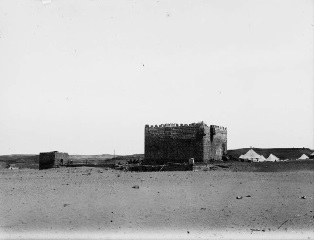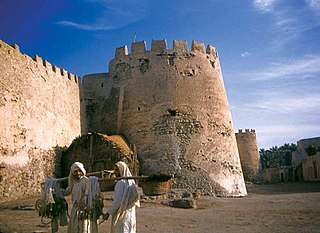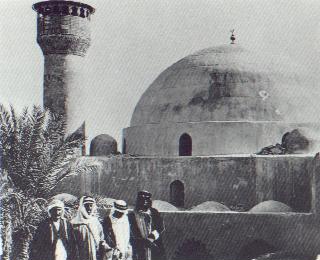
Mecca is the capital of Mecca Province in the Hejaz region of western Saudi Arabia and the holiest city in Islam. It is 70 km (43 mi) inland from Jeddah on the Red Sea, in a narrow valley 277 m (909 ft) above sea level. Its last recorded population was 2,385,509 in 2022. Its metropolitan population in 2022 is 2.4 million, making it the third-most populated city in Saudi Arabia after Riyadh and Jeddah. Around 44.5% of the population are Saudi citizens and around 55.5% are foreigners from other Muslim countries. Pilgrims more than triple the population number every year during the Ḥajj pilgrimage, observed in the twelfth Hijri month of Dhūl-Ḥijjah. With over 10.8 million international visitors in 2023, Mecca was one of the 10 most visited cities in the world.

The Hejaz railway was a narrow-gauge railway that ran from Damascus to Medina, through the Hejaz region of modern day Saudi Arabia, with a branch line to Haifa on the Mediterranean Sea.

The Eastern Province, also known as the Eastern Region, is the easternmost of the 13 provinces of Saudi Arabia. It is the nation's largest province by area and the third most populous after the Riyadh and Mecca provinces. In 2017, the population was 4,900,325. Of these, 3,140,362 were Saudi citizens and 1,759,963 were foreign nationals The province accounts for 15.05% of the entire population of Saudi Arabia and is named for its geographical location relative to the rest of the kingdom.

A kasbah, also spelled qasba, qasaba, or casbah, is a fortress, most commonly the citadel or fortified quarter of a city. It is also equivalent to the term alcazaba in Spanish, which is derived from the same Arabic word. By extension, the term can also refer to a medina quarter, particularly in Algeria. In various languages, the Arabic word, or local words borrowed from the Arabic word, can also refer to a settlement, a fort, a watchtower, or a blockhouse.

The Ajyad Fortress was an Ottoman citadel which stood on a hill overlooking the Grand Mosque of Mecca, in what is now Saudi Arabia. Built in the late 18th century, it was demolished by the Saudi government in 2002 for commercial development of the Abraj Al Bait, sparking outcry from Turkey and other concerned Muslims of the world.

Al Ahsa also known as Hajar is the largest governorate in Saudi Arabia's Eastern Province, named after the Al-Ahsa Oasis. In Classical Arabic, 'Ahsa' means the sound of water underground. It has one of the largest oases in the world with world-renowned date palms and, according to one author, the oases of Al-Hasa and Al Ain are the most important in the Arabian Peninsula. The oasis is located about 60 mi (97 km) inland from the Arabian Gulf. All urban areas are located in the traditional oasis of Al-Hasa. In addition to the oasis, the county also includes the giant Empty Quarter desert, making it the largest governorate in Saudi Arabia in terms of area. The Empty Quarter has the world's largest oil fields, and connects Saudi Arabia to Qatar, the UAE, and Oman. The Governorate's population is over 1,100,000. In the past, Al-Ahsa belonged to the historical region known as Bahrain, along with Qatif and the present-day Bahrain islands.
Qatif or Al-Qatif is a governorate and urban area located in Eastern Province, Saudi Arabia. It extends from Ras Tanura and Jubail in the north to Dammam in the south, and from the Persian Gulf in the east to King Fahd International Airport in the west. This region has its own municipality and includes the Qatif downtown, Safwa, Saihat, Tarout Island, and many other smaller cities and towns.

Al-Ahsa Oasis, also known as al-Ḥasāʾ (الْحَسَاء) or Hajar (هَجَر), is an oasis and historical region in eastern Saudi Arabia. Al-Ahsa Governorate, which makes up much of the country's Eastern Province, is named after it. The oasis is located about 60 km (37 mi) inland from the coast of the Persian Gulf. Al-Ahsa Oasis comprises four main cities and 22 villages. The cities include Al-Mubarraz and Al-Hofuf, two of the largest cities in Saudi Arabia.

Tarout or Tārūt Island is an island in the Persian Gulf belonging to the Eastern Province of Saudi Arabia, connected by three causeways to Qatif. It is six kilometers from the coast, and is the longest island in the Persian Gulf after Qeshm Island, extending from Ra’s Tannurah in the north to Qatif in the west. The island has an area of 70 square kilometers, and a population (2010) of 77,757. It contains a number of towns and villages, including Tārūt itself, Deyrah, and Darīn.

The desert castles or qasrs are often called Umayyad desert castles, since the vast majority of these fortified palaces or castles were built by the Umayyad Dynasty in their province of Bilad ash-Sham, with very few Abbasid exceptions. The desert castles of Jordan represent a prominent part of this group of buildings, with most Umayyad "desert castles" being scattered over the semi-arid regions of north-eastern Jordan, with several more in Syria, Israel and the West Bank (Palestine), and just one Abbasid exception in Iraq.

The Unification of Saudi Arabia was a military and political campaign in which the various tribes, sheikhdoms, city-states, emirates, and kingdoms of most of the central Arabian Peninsula were conquered by the House of Saud, or Al Saud. Unification started in 1902 and continued until 1932, when the Kingdom of Saudi Arabia was proclaimed under the leadership of Abdulaziz, known in the West as Ibn Saud, creating what is sometimes referred to as the Third Saudi State, to differentiate it from the Emirate of Diriyah, the First Saudi State and the Emirate of Nejd, the Second Saudi State, also House of Saud states.
The Qishla of Mecca was a fortress in Mecca, in what is now Saudi Arabia. Built in the eighteenth century as a military castle of the Ottoman Army, the building was located in the Jarwal district on the western side of the city. In the early hours of 10 June 1916, the barracks was attacked by Sharifian forces and its soldiers besieged.

The destruction of heritage sites associated with early Islam is an ongoing phenomenon that has occurred mainly in the Hejaz region of western Saudi Arabia, particularly around the two holiest cities of Islam, Mecca and Medina. The demolition has focused on mosques, burial sites, homes and historical locations associated with the Islamic prophet Muhammad, his companions, and many of the founding personalities of early Islamic history by the Saudi government. In Saudi Arabia, many of the demolitions have officially been part of the continued expansion of the Masjid al-Haram at Mecca and the Prophet's Mosque in Medina and their auxiliary service facilities in order to accommodate the ever-increasing number of Muslims performing the pilgrimage (hajj).

The hajj is a pilgrimage to Mecca performed by millions of Muslims every year, coming from all over the Muslim world. Its history goes back many centuries. The present pattern of the Islamic Hajj was established by Islamic prophet Muhammad, around 632 CE, who reformed the existing pilgrimage tradition of the pagan Arabs. According to Islamic tradition, the hajj dates from thousands of years earlier, from when Abraham, upon God's command, built the Kaaba. This cubic building is considered the most holy site in Islam and the rituals of the hajj include walking repeatedly around it.

Al-Ukhaydir, also known as Haydar or Aqabat, is a site in the Tabuk Province in Saudi Arabia, located southeast of Tabuk. During early Ottoman rule, a fort, Qal'at al-Akhdar, was built at the site, part of the larger network of fortifications along the Hajj caravan route to Medina and Mecca.

Fort Tarout or Tarout Castle is a historic castle located at the top of a hill in the center of Tarout Island, eastern Saudi Arabia. The base at which the castle was built on goes back to 5000 BC. The castle itself was built on the base of an old Phoenician temple, that was dedicated to Astarte, during the Uyunid Emirate (1076–1253). Other researchers believe that it was built in the 16th century between 1515 and 1520 AD during Portuguese invasion of Pesian gulf and was one of their dereferense point after they restored it on 24 March 1544.

Asfan Castle is a historical edifice in Asfan Village, 30 km North of both Jeddah and Mecca, Saudi Arabia, built in the eighteenth century -Exact date is disputed- as an outpost of the Ottoman army, Monitoring the road between Mecca and Medina.

Qal'at al-Qatif or Qatif Castle was a historic castle in the city of Qatif, Saudi Arabia. Initial construction of the castle dates back to the third century by the Sassanids. It was then refurbished by the Ottomans and utilized as a defensive military base for the Persian Gulf region. Later, the castle was turned into a civilian-purpose warehouse for the locals. The castle itself was a massive complex of densely populated area and several facilities, including eleven mosques, a keep for the king, keeps for the guests, which are surrounded by the citadel wall. It was oval-shaped, and John Gordon Lorimer estimated that the longest side reaches 365 meters from the east to west, and it reaches 275 meters from the north to south. At its peak, it contained the population of 5,000, and 300 shops. It also equipped moat and farmlands for orchard, connected to nearby Qatif oasis. The castle was destroyed in the 1980s, after the ownership was taken away from the locals, and the buildings and houses were gradually removed. Today, there are only 18 houses left in the field with the rest of the places turned into a public square and parking lots.

Qasr Ibrahim is a historic fort in the north of Alqoat neighborhood, Hofuf, Al-Ahsa, Eastern Province, Saudi Arabia. It is also called the Dome Palace, AlQoat Palace or Ibrahim Castle and is the region's main architectural heritage site from the Ottoman period. It served as a Turkish military base. It was seized by King Abdul-Aziz Al Saud on April 13, 1913.
The archaeology of Saudi Arabia includes the following archaeological sites:


















